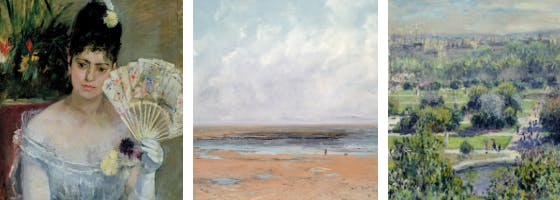Monet: Impression Sunrise - The Curators Insight
See the painting that defined Impressionism, Claude Monet's Impression, Sunrise, visiting Australia for the first time in an exhibition at the National Gallery of Australia, 7 June - 1 September 2019. For an insight into this EXCLUSIVE exhibition, we sat down with the Co-ordinator Curator, Simeran Maxwell.

Whilst the exhibition is titled Monet: Impression Sunrise it won’t just be Monet on display?
Monet and his seminal painting, Impression, sunrise 1872, is the heart of this exhibition: it shows how the young artist came to paint the work, his influences and, in turn, his impact on subsequent generations. The exhibition includes works by master landscape artists who came before Monet, who shaped the ways he looked at the French landscape and applied paint to canvas. The second half of the exhibition demonstrates how Monet continued to refine these ideas for the rest of his life, ending with his famous Waterlilies series.
What is impressionism and how did this movement come about?
Monet’s painting of the Port of Le Havre at sunrise which he named Impression, sunrise, was exhibited at the First Impressionist exhibition in Paris in 1874. This exhibition was such a shock to many of the art critics: the group was derisively named Impressionists, as in they hadn’t even bothered to finish their works and that they were only an impression or sketch of the subject. Monet and his contemporaries are now some of the most important, and most-loved, artists of all time!
There will be 60 works in the exhibition. Can you tell us some absolute must-see pieces?
Obviously the most important painting in the show to see is Impression, sunrise. This work rarely leaves its home in Paris and has never travelled the southern hemisphere. We are so fortunate to be able to show it here in Canberra! Other key paintings include the Turners, those by Monet’s teacher Eugene Boudin, as well as Monet’s masterpieces of his middle and late periods: The Tuileries 1876; The Pont de l’Europe. Saint‑Lazare Station 1877; and Waterlilies 1903.
Where are the pieces coming from?
As well as the treasures from Musée Marmottan Monet, we have collaborated with Tate, Yale Centre for British Art, several French regional museums and the most important public and private collections in Australia and New Zealand. The exhibition also features the National Gallery’s own Haystacks 1890—newly cleaned of the varnish that impacted its colours—and Waterlilies c 1914–17.
How long has the exhibition been in planning?
The Musée Marmottan Monet in Paris launched a variant exhibition in 2014, to celebrate the 80th anniversary of its opening, and to celebrate new research into Impression, sunrise; this version of the show, especially prepared for Canberra, has come about relatively quickly, and is Director Nick Mitzevich’s first major project at the National Gallery.

What makes Monet’s paintings still so intriguing after 150 years?
Monet and the other Impressionists approached art and their subject matter in completely new ways. They are painters of modern life – the ports, train stations and public places of modern Paris, as well as intimate scenes of daily existence – and they revolutionised the ways artists worked: often out-of-doors, using portable easels and paint in tubes, and holding independent exhibitions, away from the Salon. Monet’s great contribution to art was to capture the effects of light, the momentary impressions of atmospheric conditions, and to produce works in series. His final, grand waterlily cycle consumed him more than 20 years.
What are the major challenges in putting an exhibition like this together?
Persuading people to part with their treasures, even temporarily, is always a challenge! In this case, the director and curators of the Musée Marmottan Monet fully supported the need for art lovers in Australia to experience the iconic Impression, sunrise, to understand the genesis of Impressionism and appreciate the collections.
For people who are art novices, why should they attend this exhibition?
Quite simply: Monet is wonderful and Impression, sunrise is one of his most important works. Understanding how and why Monet produced the painting, and why it changed the course of art history, is a chance in a life time!



